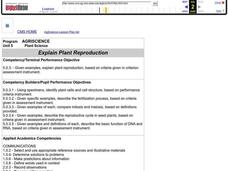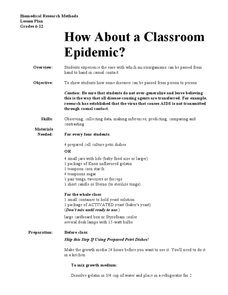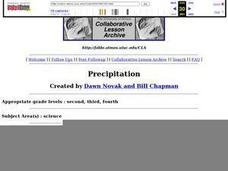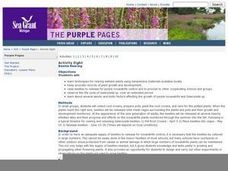Curated OER
Biomes and Plant Growth
Seventh graders design four biomes models and plant three types of seeds in them to observe growth. In groups for each type of biome, they predict the seeds' growth in each of the settings. Students follow the conditions on a biome chart...
Curated OER
Plant Reproduction
Students plant seeds in order to investigate and explore the questions: "How do seed companies develop varieties of plants?" and "What is the ideal plant?" Students will study related vocabulary and sketch seeds as they emerge. Students...
Curated OER
How About a Classroom Epidemic?
Have individuals wash their hands with soap and water, give one of them a yeast-covered piece of candy, and then have him shake hands with the person next to him. Handshakes continue down the line until everyone in the class has had...
Newspaper Association of America
Cereal Bowl Science and Other Investigations with the Newspaper
What do cereal, fog, and space shuttles have to do with newspapers? A collection of science investigations encourage critical thinking using connections to the various parts of the newspaper. Activities range from building origami seed...
Curated OER
Forming a Hypothesis
In this hypothesis worksheet, students read about how to form a hypothesis and how to collect observations. Students go through the 4 steps of forming a hypothesis.
Curated OER
Fun with Flowers
Students make observations of flowers. In this life science activity, students look at flowers, then draw and color their favorite flowers. Lesson includes extension activities.
Curated OER
Drawing From Nature
Students observe similarities and differences of natural objects. In this observation lesson, students use a magnifying glass to identify the details of objects.
Curated OER
Precipitation - Pot of Ice/Pot of Boiling Water Experiment
Students observe an experiment where a pot of ice is held over a pot of boiling water. They predict what will happen and then share what they see as the experiment takes place. Then the concept of condensation and precipitation is...
Curated OER
Botany Basics
Students survey plants. In this plant identification lesson plan, students explore the difference in plants to aid identification. Students determine which plants may be used for medicinal reasons.
Curated OER
Beetle Rearing
Students investigate plants and the effects beetles have on the plants. In small groups, they collect plants and observe the beetles as they interact with the plants. They record the conditions including temperature, cloudiness, length...
Curated OER
Rain Forest Terrariums
Fifth graders make rain forest terrariums in order to observe a simulated mini-environment. They place the layers and plants into container and place where it can be observed. They observe the closed water system in the container before...
Curated OER
Get to The Root of It!
Pupils study a real plant to explore its parts. They discover the function of the plant parts which they diagram and label.
Curated OER
The Abiotic Limits to Purple Loosestrife Growth
Students investigate the effects of soil temperature, water availability, photo period and other variables of the growth of purple loosestrife. They observe the growing conditions of plants and alter them by adding water, isolating the...
Nuffield Foundation
A Closer Look at Blood
Here is a lab that has teenage scientists examining samples of their own blood under a microscope. Learners carefully prepare slides, then make detailed observations and identifying different types of cells using a key.
Curated OER
The Delany Garden
Young scholars design and create a garden. They select flowers in small groups and research them. They draw a diagram of the landscape for their garden and plant flowers and observe them as they grow.
Curated OER
This is Cool!
Third and fourth graders who are studying states of matter will enjoy this simple exercise. In it, they look at a picture of a girl in her kitchen, and they must circle five examples of materials that have changed states of matter as...
Curated OER
Ghost Crystals - Light & Water
Woo, ghost crystals, just in time for Halloween! Young scientists experiment with light and water as they make and observe ghost crystals. The lesson does not include the process for making the crystals, but provides a web link where a...
Curated OER
Do Plants Need Water?
First graders observe the effects of varying amounts of water, sun, and air on lima bean plants. They also predict and describe their outcomes in a written report.
Curated OER
Discovering Seeds
Young scholars compare seeds with seedlings. In this life science lesson, students make observations of seedlings and the seeds they grew from, paying special attention to the roots. Lesson includes extension activities.
Curated OER
Somethin' Sweet
Students make their own candy. In this science lesson plan, students observe how molecules interact with each other in physical changes and observe how the addition of heat can cause molecules to interact and form new molecules in...
Curated OER
Condensation
Students participate in the scientific process to investigate what happens to water when it evaporates by observing condensation. In small groups they observe what happens to ice in a cup, and what occurs when they hold a bowl of ice...
Curated OER
Jack and the Beanstalk
Third graders read a story and grow a beanstalk. In this literature and life science lesson, the class reads "Jack and the Beanstalk," then lists fairy tale elements and write a puppet show. The students plant pinto beans and observes...
Curated OER
Parts of the Plants
Second graders discuss as a class what they know about plants viewing several pictures of plants as well as a tree poster. They work in groups to observe a flowering plant which is removed from a pot with the soil brushed away and is...
Curated OER
Making a Terrarium
Students become familiar with the materials needed to build a terrarium. In this terrarium lesson, students create a terrarium in a bottle and observe how it grows and takes care of itself.

























